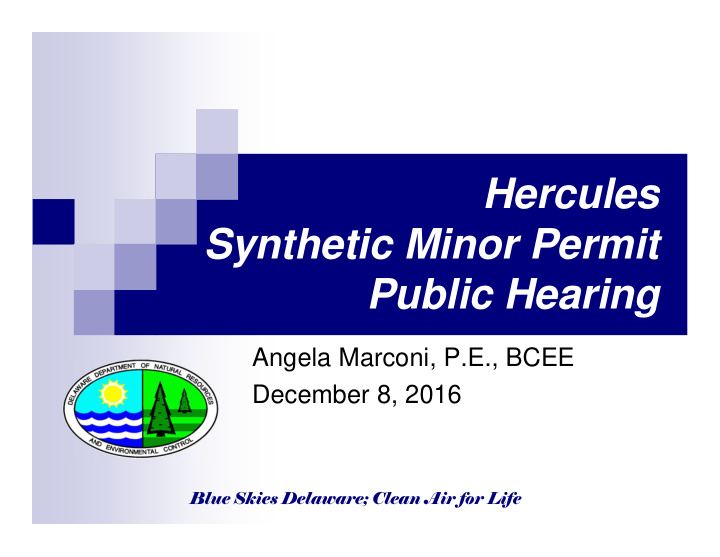



Hercules Synthetic Minor Permit Public Hearing Angela Marconi, P.E., BCEE December 8, 2016 Blue Skies Delaware; Clean Air for Life
Agenda � Opening Remarks - Presiding Hearing Officer � Robert P. Haynes, Esq. Office of the Secretary � DAQ’s Presentation � Angela Marconi, P.E., BCEE � Applicant’s Presentation � Tom Baker, Hercules � Richmond Williams, Hercules � Public Speakers-pre-registered first then from sign-in sheet. Blue Skies Delaware; Clean Air for Life
Overview � Division of Air Quality � Public Hearing Process � DAQ Permit Process � Project Scope � Permit Conditions � Applicant � Presentation of application/project Blue Skies Delaware; Clean Air for Life
After the Public Hearing � Public comment period closed by Hearing Officer � DAQ and Applicant respond to comments and questions raised � Hearing Officer prepares report for the Secretary � Secretary makes decision and Secretary’s Order makes it official Blue Skies Delaware; Clean Air for Life
DAQ Air Permit Process � Facility Background � First permit issued 1979 � Title V Facility since 1999 � Request to downsize to Synthetic Minor in 2012 Blue Skies Delaware; Clean Air for Life
DAQ Air Permit Process � Summary of events � Application for four spray dryers received in 2013 � Construction permit advertised and issued in 2014 � Operating permit for one Dryer issued October 2015 � Facility and Department begin permit transition from Title V to Synthetic Minor December 2015 � Application resubmitted May 2016 as one SM permit with more accurate potential to emit (PTE) limits. � Synthetic Minor permit advertised Sept 2016 Blue Skies Delaware; Clean Air for Life
DAQ Air Permit Process � Sept 2016 public meeting comments � Zoning Concerns � Emissions Concerns � Monitoring/Testing Requirements Blue Skies Delaware; Clean Air for Life
Project Scope � Facility houses corporate administrative buildings and Research and Development labs. � The facility property is zoned Office Regional � Allows Light Industry including R&D facilities “where the facility generally resembles an industrial or manufacturing facility” Blue Skies Delaware; Clean Air for Life
Project Scope � Spray Dryers � Four units � Used for R&D for the pharmaceutical industry � The process recovers pharmaceutical powder that is suspended in solvent � Emissions are from solvents used in the spray drying process Blue Skies Delaware; Clean Air for Life
Project Scope Units Pollution Control � Four spray dryers � All four spray dryers vent to the carbon adsorbers. � PSD-1 GMP Spray Dryer � PSD-1 R&D Spray Dryer � The two PSD-1 spray � SD Micro Spray Dryer dryers have condensers � MP-1 Fluid Bed that collect most of the � Carbon Adsorption solvent in liquid form. System Blue Skies Delaware; Clean Air for Life
Project Scope Blue Skies Delaware; Clean Air for Life
DAQ Permitting � Permits Conditions � Emission limits protective of human health and the environment � Minimal visible emissions � Maintain records for a minimum of 5 years � Operating data � Material Safety Data Sheets � Carbon Bed Usage Log � Relevant employee training � Emissions Tracking � Maintenance � Report deviations from permitted conditions Blue Skies Delaware; Clean Air for Life
DAQ Permitting � How will emissions be tracked? � Material Balance � The emissions are directly proportional to the quantity of solvent used. � Carbon beds changed at 85% capacity, based on usage. � Weekly checks of control equipment � Leak check using soapy water solution � Breakthrough test using Dragger tube (or equivalent) Blue Skies Delaware; Clean Air for Life
Emissions Summary � Seven solvents are permitted for use in the spray dryers Solvent Pollutant Ethanol VOC Isopropyl Alcohol VOC Ethyl Acetate VOC Tetrahydrofuran VOC Methanol VOC/HAP Methylene Chloride HAP - Acetone Blue Skies Delaware; Clean Air for Life
Emissions Summary � The permit limits are conservative values with several worst case assumptions � All four spray dryers are operating simultaneously � Operating each unit at the maximum capacity � All batches are of the most volatile solvent Annual PTE Pollutant (tons/yr) Scenario 1 Acetone 2.9 Scenario 2 VOC 2.5 Scenario 3 HAP 3.1 Blue Skies Delaware; Clean Air for Life
Emissions Modeling � 2014 Threshold limit values (TLVs) and BEIs, published by the American Conference of Governmental Industrial Hygienists (ACGIH). � EPA’s Screen 3 Model � The Department requires the ratio of the Threshold Limit Value to the Maximum Downwind Concentration (TLV: MDC) is at least 100:1 at the nearest property boundary line and beyond for each air contaminant released. Solvent Pollutant TLV : MDC Ethanol VOC 20929 Isopropyl Alcohol VOC 6519 Ethyl Acetate VOC 4204 Tetrahydrofuran VOC 277 Methanol VOC/HAP 1715 Methylene Chloride HAP 129 Acetone - 1796 Blue Skies Delaware; Clean Air for Life
Condensers � PSD spray dryers are equipped with solvent condensers. Maximum Condenser Solvent Temperature (°C) Ethanol 5 Isopropyl Alcohol 5 Ethyl Acetate 5 Tetrahydrofuran 5 Methanol 5 Methylene Chloride -10 Acetone 5 Blue Skies Delaware; Clean Air for Life
Operating Limitations � Only one spray dryer may operate using Methylene chloride at any time � Spray dryers are not permitted to operate without condensers (if applicable) and carbon beds operating properly � All structural and mechanical components of process must be maintained in proper operating condition. Blue Skies Delaware; Clean Air for Life
Thank You Blue Skies Delaware; Clean Air for Life
Recommend
More recommend